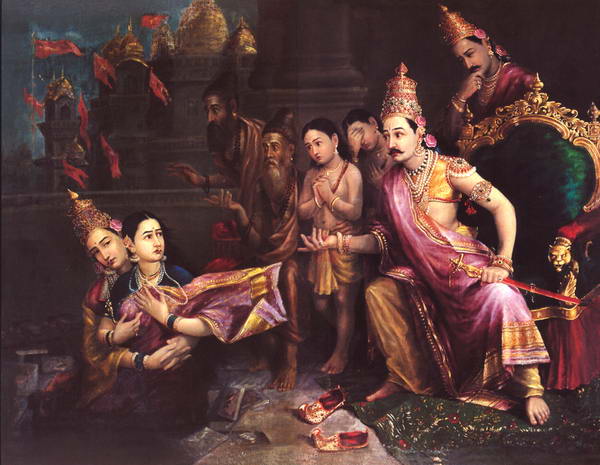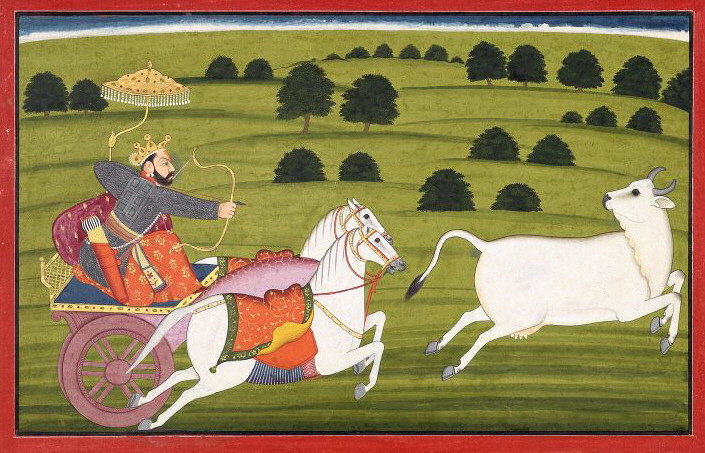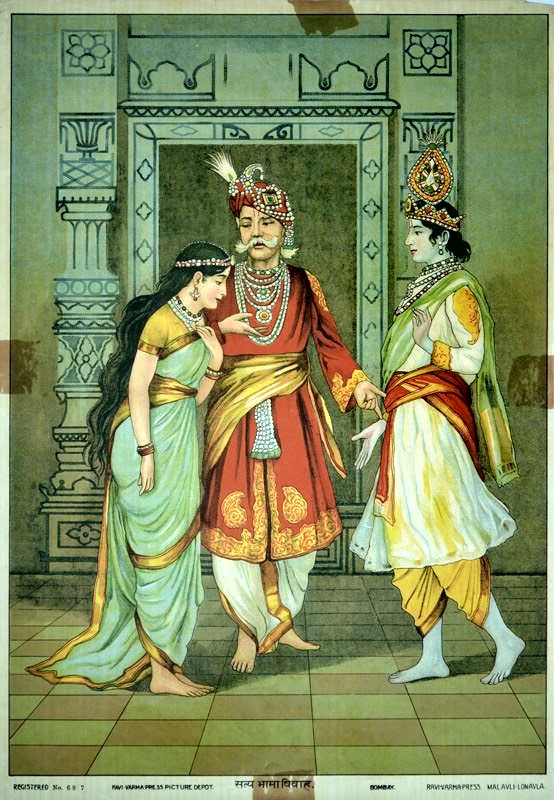|
Bhudevi
Bhumi (Sanskrit: भूमि, romanized: Bhūmi), also known as Bhudevi, Dharani, and Vasundhara, is a significant goddess in Hinduism, personifying the Earth. Her earliest form is reflected in the Vedic goddess Prithvi, though their roles and depictions are drastically different. Bhumi features prominently in the ''Mahabharata'' and various Puranas. According to Vaishnava tradition, she is the second consort of Vishnu, along with Sridevi and Niladevi. As per Hindu mythology, Varaha, the third avatar of Vishnu, saved her from the asura Hiranyaksha and later married her, making her one of his consorts. After this rescue, Varaha and Bhumi have a son named Mangala. Bhumi also bears Narakasura, an asura, due to Hiranyaksha's influence. In the epic ''Ramayana'', she is mentioned as the mother of Sita, the epic's female protagonist. Bhumi is described to be born as Satyabhama, the consort of Krishna, to assist in slaying Narakasura. The Alvar saint Andal is also considered an avat ... [...More Info...] [...Related Items...] OR: [Wikipedia] [Google] [Baidu] |
Prithvi
Prithvi (Sanskrit: पृथ्वी, ', also पृथिवी, ', "the Vast One", also rendered Pṛthvī Mātā), is the Sanskrit name for the earth, as well as the name of the goddess-personification of it in Hinduism. The goddess Prithvi is an archetypal Mother Goddess, and one of the most important goddesses in the historical Vedic religion. She is depicted as a stable, fertile, and benevolent presence in the Vedas. She is frequently addressed as a mother, and a nurturing, generous goddess who provides sustenance to all beings living on her vast, firm expanse. While the ''Rigveda'' predominantly associates her with Dyaus ('Father Sky'), the ''Atharvaveda'' and later texts portray her as an independent deity. In classical Hinduism, the figure of Prithvi is supplanted by the goddess Bhumi, while the term Prithvi serves as one of her epithets. She becomes significantly associated with Vishnu, one of the most important gods in later Hinduism, and his avatars—Varaha ... [...More Info...] [...Related Items...] OR: [Wikipedia] [Google] [Baidu] |
Niladevi
Niladevi (), also rendered as Neela Devi or Nappinnai, is a Hindu goddess, and a consort of the preserver deity Vishnu, along with Sridevi and Bhudevi. Niladevi is primarily revered in South India, particularly in Tamil culture, as one of Vishnu's consorts. In Sri Vaishnava tradition, all three consorts of Vishnu are regarded as aspects of Mahalakshmi. In Vishnu's avatar as Krishna, Niladevi is either regarded as Nagnajiti, the consort of Krishna in Dvārakā or in some accounts, as southern counterpart of Radha, the gopi consort of Krishna in North Indian traditions. Legend According to regional traditions, Niladevi took the incarnation of Nagnajiti, a wife of Krishna. In Sri Vaishnavism, Nagnajiti is also called Nappinnai (Pinnai, a favourite gopi of Krishna in Tamil tradition). Niladevi appears in the '' Vaikhanasa Agama'' text. Some texts mention that Vishnu's '' iccha shakti'' takes three forms: Sridevi, Bhudevi, and Niladevi, representing the three ''guna ... [...More Info...] [...Related Items...] OR: [Wikipedia] [Google] [Baidu] |
Narakasura
Naraka, also known as Narakāsura, and Bhaumāsura was an asura king, the legendary progenitor of all three dynasties of Pragjyotisha-Kamarupa, and the founding ruler of the legendary Bhauma dynasty of Pragjyotisha. Though the myths about Naraka are first mentioned in the Mahabharata, later texts embellish them. According to later post-Vedic texts such as the Brahma Purana and Vishnu Purana, he was the son of Bhudevi, fathered by the Varaha incarnation of Vishnu. He is claimed as one who established Pragjyotisha. He was slain by Krishna and Satyabhama. His son Bhagadatta—of Mahabharata fame—succeeded him. The 10th/11th-century Kalika Purana embellishes the myths further and he is claimed to have come from Mithila and said to have established the kingdom of Pragjyotisha after overthrowing the last of the Kirata kings, Ghatakasura, of the Danava dynasty. It was foretold that he would be destroyed by a later incarnation of Vishnu. His mother, the earth, sought the ... [...More Info...] [...Related Items...] OR: [Wikipedia] [Google] [Baidu] |
Lakshmi
Lakshmi (; , , sometimes spelled Laxmi, ), also known as Shri (, , ), is one of the principal goddesses in Hinduism, revered as the goddess of wealth, fortune, prosperity, beauty, fertility, sovereignty, and abundance. She along with Parvati and Sarasvati, form the trinity of goddesses called the Tridevi. Lakshmi has been a central figure in Hindu tradition since pre-Buddhist times (1500 to 500 BCE) and remains one of the most widely worshipped goddesses in the Hindu pantheon. Although she does not appear in the earliest Vedic literature, the personification of the term '' shri''—auspiciousness, glory, and high rank, often associated with kingship—eventually led to the development of Sri-Lakshmi as a goddess in later Vedic texts, particularly the ''Shri Suktam''. Her importance grew significantly during the late epic period (around 400 CE), when she became particularly associated with the preserver god Vishnu as his consort. In this role, Lakshmi is seen as the ide ... [...More Info...] [...Related Items...] OR: [Wikipedia] [Google] [Baidu] |
Satyabhama
Satyabhama (IAST'': Satyabhāmā)'' , also known as Satrajiti, is a Hindu goddess and the third queen consort of the Hindu god Krishna. Satyabhama is described as an incarnation of Bhumi, an aspect of Lakshmi. She is the goddess and the personification of the Earth. She has two sisters named Vratini and Prasvapini who are her co-wives as well. According to some traditions, she is regarded to have aided Krishna in defeating the asura Narakasura. Legend Marriage to Krishna Satyabhama was the daughter of Yadava King Satrajita, the royal treasurer of Dvaraka, who was the owner of the Syamantaka jewel. Satrajita, who secured the jewel from the sun-god Surya and would not part with it even when Krishna, the king of Dvaraka, asked for it saying it would be safe with him. Shortly thereafter, Prasena, the brother of Satrajita, went out hunting wearing the jewel but was killed by a lion. Jambavan, known for his role in the Ramayana, killed the lion and gave the jewel to his ... [...More Info...] [...Related Items...] OR: [Wikipedia] [Google] [Baidu] |
Varaha
Varaha (, , "boar") is the avatar of the Hinduism, Hindu god Vishnu, in the form of a wild boar, boar. Varaha is generally listed as third in the Dashavatara, the ten principal avatars of Vishnu. In legend, when the demon Hiranyaksha steals the earth goddess Bhumi (goddess), Bhumi and hid her in the primordial waters, Vishnu appears as Varaha to rescue her. Varaha kills Hiranyaksha and retrieves the earth from the cosmic ocean, lifting her on his tusks, and restores her to her place in the universe. Varaha is depicted as a boar or in an anthropomorphic form, with a boar's head and the human body. Varaha often depicted lifing his consort Bhumi, the earth. Etymology and other names The deity Varaha derives its name from the Sanskrit word ''varaha'' (Devanagari: वराह, ) meaning "boar" or "wild boar". The word ''varāha'' is from Proto-Indo-Iranian language, Proto-Indo-Iranian term ''warāȷ́ʰá'', meaning boar. It is thus related to Avestan ''varāza'', Kurdish lan ... [...More Info...] [...Related Items...] OR: [Wikipedia] [Google] [Baidu] |
Hindu Mythology
Hindu mythology refers to the collection of myths associated with Hinduism, derived from various Hindu texts and traditions. These myths are found in sacred texts such as the Vedas, the Itihasas (the ''Mahabharata'' and the ''Ramayana''), and the Puranas. They also appear in regional and ethnolinguistic texts, including the Bengali ''Mangal Kavya'' and the Tamil '' Periya Puranam'' and ''Divya Prabandham''. Additionally, Hindu myths are also found in widely translated fables like the ''Panchatantra'' and the '' Hitopadesha'', as well as in Southeast Asian texts influenced by Hindu traditions. Meaning of "myth" Myth is a genre of folklore or theology consisting primarily of narratives that play a fundamental role in a society, such as foundational tales or origin myths. For folklorists, historians, philosophers or theologians this is very different from the use of "myth" simply indicating that something is not true. Instead, the truth value of a myth is not a def ... [...More Info...] [...Related Items...] OR: [Wikipedia] [Google] [Baidu] |
Mangala
Mangala (, IAST: ) is the personification, as well as the name for the planet Mars, in Hindu literature. Also known as Lohita (), he is the deity of anger, aggression, as well as war. According to Vaishnavism, he is the son of Bhumi, the earth goddess, and Vishnu, born when the latter raised her from the depths of the primordial waters in his Varaha avatar. According to Shaivism, he was born from the god Shiva through a drop of his blood or sweat. Nomenclature Mars (Mangala) is also called: * Raktavarna (रक्तवर्ण) - whose color is like blood. * Bhauma (भौम) - son of Bhumi. * Lohitānga (लोहिताङ्ग) - red bodied (Loha also means Iron, so could also mean Iron Bodied). * Kuja (कुज) - he who is born from Earth. * Bha (भ) - shining. * Dharāputra (धरापुत्र) - son of Dharā. Iconography He is painted red or flame colour, four-armed, carrying a trident (), mace (), lotus (), and a spear (). His mount () is a ram. He ... [...More Info...] [...Related Items...] OR: [Wikipedia] [Google] [Baidu] |
Andal
Andal (ISO 15919: Āṇḍāḷ), also known as Godhai, Nachiyar, and Godha Devi, is the only female Alvars, Alvar. (Orthodoxy posits the number of Alvars as ten, though there are other references that include Andal and Madhurakavi Alvar, making the number twelve.) She is an avatar, avatara of the earth goddess Bhumi (goddess), Bhumi, consort of the preserver god Vishnu. As with the other Alvars, she was affiliated with the Sri Vaishnavism, Sri Vaishnava tradition of Hinduism. She was raised by Periyalvar in Srivilliputhur, where she grew up as an ardent devotee of Vishnu as Krishna. Active in the 8th-century CE, Andal is credited with two great Tamil language, Tamil works, ''Tiruppavai'' and ''Nachiyar Tirumoli'', which are still recited by devotees during the winter festival season of Margali. Andal is a prominent figure for women in South India and has inspired several women's groups such as Goda Mandali. History According to literary and religious tradition, Periyalv ... [...More Info...] [...Related Items...] OR: [Wikipedia] [Google] [Baidu] |
Vaikuntha
Vaikuntha (), also called Vishnuloka (), and Tirunatu (Tirunāṭu) in Tamil language, Tamil, is the abode of Vishnu, the Parabrahman , supreme deity in the Vaishnavism, Vaishnava tradition of Hinduism,Gavin Flood, An Introduction to Hinduism' (1996). and his consort, Lakshmi, the supreme goddess of the sect. According to Ramanuja, Vaikuntha is the ''Parama Padam'' or ''Nitya Vibhuti,'' an "eternal heavenly realm", and is the "divine imperishable world that is God's abode". In Vaishnava literature, Vaikuntha is described as the highest realm above the fourteen ''lokas'' (worlds), and the place where the devotees of Vishnu go upon achieving Moksha, liberation. It is guarded by the twin deities, Jaya-Vijaya, Jaya and Vijaya, the Dvarapala, dvarapalakas, or gatekeepers of Vaikuntha. The army of Vishnu, stationed at Vaikuntha, is led by Vishvaksena. The planets of Vaikuntha are described as being full of golden palaces and hanging gardens that grow fragrant fruits and flowers. The p ... [...More Info...] [...Related Items...] OR: [Wikipedia] [Google] [Baidu] |
Vishnu
Vishnu (; , , ), also known as Narayana and Hari, is one of the Hindu deities, principal deities of Hinduism. He is the supreme being within Vaishnavism, one of the major traditions within contemporary Hinduism, and the god of preservation (sattva). Vishnu is known as ''The Preserver'' within the Trimurti, the triple deity of Para Brahman, supreme divinity that includes Brahma and Shiva.Gavin Flood, An Introduction to Hinduism' () (1996), p. 17. In Vaishnavism, Vishnu is the supreme Lord who creates, protects, and transforms the Hindu cosmology, universe. Tridevi is stated to be the energy and creative power (Shakti) of each, with Lakshmi being the equal complementary partner of Vishnu. He is one of the five equivalent deities in Panchayatana puja of the Smarta tradition of Hinduism. According to Vaishnavism, the supreme being is with qualities (Saguna Brahman, Saguna), and has definite form, but is limitless, transcendent and unchanging absolute Brahman, and the primal Atma ... [...More Info...] [...Related Items...] OR: [Wikipedia] [Google] [Baidu] |
Mahabharata
The ''Mahābhārata'' ( ; , , ) is one of the two major Sanskrit Indian epic poetry, epics of ancient India revered as Smriti texts in Hinduism, the other being the ''Ramayana, Rāmāyaṇa''. It narrates the events and aftermath of the Kurukshetra War, a war of succession between two groups of princely cousins, the Kauravas and the Pandava, Pāṇḍavas. It also contains Hindu philosophy, philosophical and devotional material, such as a discussion of the four "goals of life" or ''puruṣārtha'' (12.161). Among the principal works and stories in the ''Mahābhārata'' are the ''Bhagavad Gita'', the story of Damayanti, the story of Shakuntala, the story of Pururava and Urvashi, the story of Savitri and Satyavan, the story of Kacha (sage), Kacha and Devayani, the story of Rishyasringa and an Ramopakhyana, abbreviated version of the ''Rāmāyaṇa'', often considered as works in their own right. Traditionally, the authorship of the ''Mahābhārata'' is attributed to Vyasa, Vy ... [...More Info...] [...Related Items...] OR: [Wikipedia] [Google] [Baidu] |






